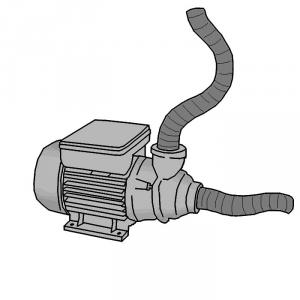Resumen ejecutivo
Mechanised pumps are water-lifting devices used to withdraw water from surface water sources, groundwater sources and reservoirs or to pump water into distribution systems. Mechanised pumps can be driven by various power sources (e.g. electricity, solar energy, fuels, wind energy, animals, and gravity). As a limiting factor, installation, operation and maintenance is capital intensive, requires a high level of technical skills and the availability of spare parts, fuel, lubricant, etc. However, most mechanised pumps have a very high performance and thus can suit and optimise urban or large rural water supply systems. Yet, the choice of the power source and the pump type has many implications, which should be carefully considered prior to implementation.
| Entradas | Salidas |
|---|---|
Freshwater, Drinking Water |
Introduction
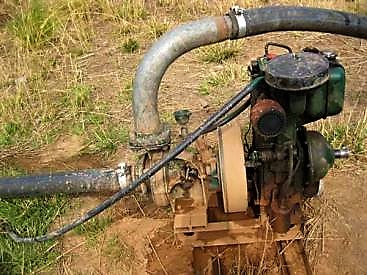
Water-lifting devices are used to lift water to a height that allows direct access. They can be used to withdraw water from surface water sources (lakes, rivers or reservoirs), groundwater sources (hand dug wells or drilled wells) and reservoirs or to pump water into distribution systems. Clearly, water-lifting devices can serve both household use, industries and, or agricultural water supplies (e.g. irrigation). Mechanised pumps (as opposed to human powered water pumps) may be driven by various power sources: electricity, fuels, animals, wind power, solar power, and gravity. The term ‘motorised pumps’ is mainly associated with diesel- and electro pumps.
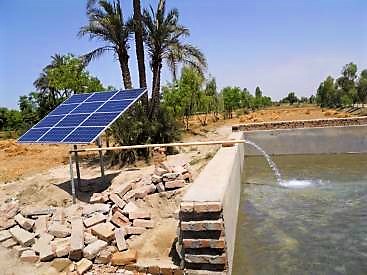
Although mechanised pumps are capable of lifting very large amounts of water, their use is limited since the installation, operation and maintenance of most mechanised pumps is capital intensive, requires a high level of technical skills and the availability of spare parts, fuel, lubricant, etc.
After gaining high popularity in developing countries in the 70s and 80s, studies have showed that many pumps did not proof to sustain due to lack of maintenance (ROARK et al. 1989). Lately, human powered pumps have been strongly promoted and many good technologies have evolved. Yet, for large community water supplies, urban drinking water systems and in agriculture, the use of mechanised pumps is not to be avoided. Although the currently prevailing scepticism for mechanised pumps is justified, in such cases, their use can be a good solution.
Design Principles
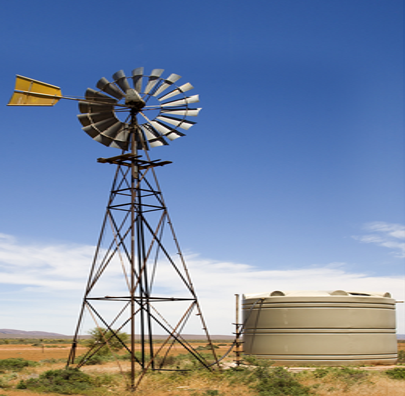
Many different mechanised pumping systems have been developed. A pumping system consists of a pump and a motor or engine. Hence, choosing a pump system includes choosing a pump type and a power source. Although many pump types suit different power sources, some combinations have proven to be more effective.
The choice of pump and power source mainly depends on the purpose (i.e. medium or large scale drinking water supply or irrigation system), on the availability of power sources, fuel and spare parts and on resources for maintenance.
Pumps make use of one single or a combination of those principles (BAUMANN 2000).
- Direct lift: Water is physically lifted in a container.
- Displacement: Water is incompressible. Hence, it can be pushed or displaced (reciprocating technique).
- Creating a velocity head: Water can be propelled to a high speed. The momentum produced can be used either to create a pressure or a flow (Rotary technique).
Based on those principles, many different pump types have been designed: submersible pumps, centrifugal pumps, jet pumps, progressive cavity (Mono) pumps, etc.
The following table summarises the most important aspects of different power sources used for pumping.
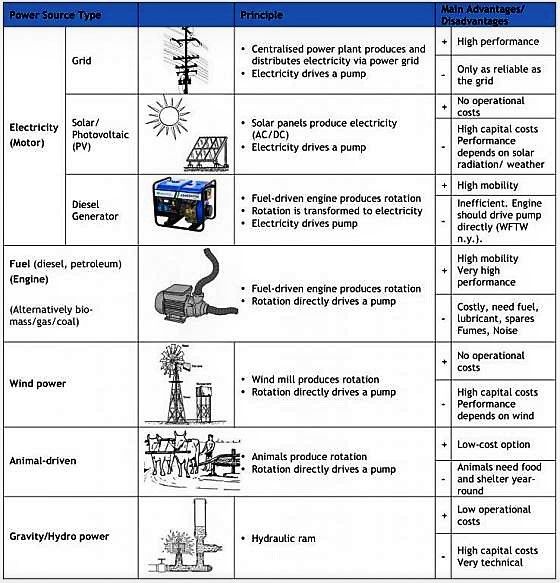
Costs and O&M
Capital costs for mechanised pumps are mainly associated with the purchase of the pump, installation, and, depending on the type, high costs for fuel, spare parts, lubricants and technical maintenance. Unlike for human powered pumps, low-cost options for mechanised pumps hardly exist.

Health Aspects
Most mechanised pumps require a closed well with apron minimising superficial contamination. Yet, adequate well maintenance and water source protection is required. Nevertheless, mechanised pumps using fuels pose a high risk of groundwater contamination. Diesel, petroleum and other fuels spilled on unprotected ground can infiltrate the aquifer and cause the surrounding wells to become inoperative. Also, engines produce fumes and noise that can be hazardous to people working in close proximity for a long period.
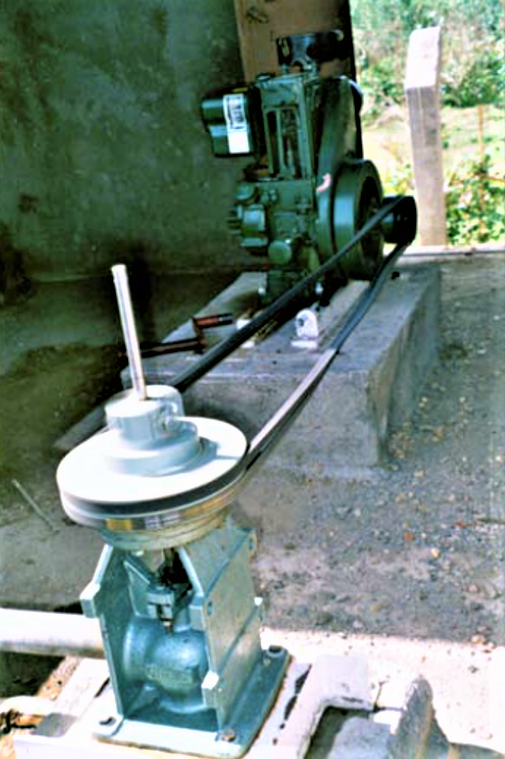
Overview
| Working Principle | An engine, driven by a (non-human) power source, lifts groundwater from wells. |
| Capacity/Adequacy | Where electricity is largely available and depth does not allow hand pumps, e.g. large irrigation systems and urban drinking water supplies. |
| Performance | Very high performance if correctly maintained and operated |
| Costs | Generally high capital, operation and maintenance costs. |
| Self-help Compatibility | Usually rather low to moderate; repair kits, spare parts, lubricant and fuel are necessary. |
| O&M | Depends on the system (pump type and power source). |
| Reliability | Depends on the system (pump type and power source) and level of maintenance. |
| Main strength | High performance. |
| Main weakness | High costs. |
Recently, human powered pumps have strongly been promoted and many good technologies have evolved. Yet, for large community water supplies, urban drinking water systems and in agriculture, requiring high performance water supply, the use of mechanised pumps can be appropriate (ROARK et al. 1989). Mechanised pumps can be more appropriate than hand pumps for:
- Areas where a storage and distribution system is necessary (e.g. rural hospitals), economically feasible (e.g. high density poor urban neighbourhoods), or desired by a community willing and able to pay the higher capital, operation and maintenance costs associated with such a system;
- Areas with a relatively inexpensive and reliable source of energy (usually electricity) and availability of spare parts, skills, lubricants, and fuel;
- Situations where greater yields than those available from a hand pump are required (e.g. communities with only one drilled well which require water for additional uses such as cattle and irrigation);
- Areas where the only available water is deep-lying groundwater;
- Some emergency situations (e.g. rapidly expanding refugee camps)(UNICEF 1999).
Water Lifting
This comprehensive manual presents different pumps and water lifting techniques and elaborates on technology choice and the role of the institutional framework.
BAUMANN, E. (2000): Water Lifting. (= Series of Manuals on Drinking Water Supply , 7 ). St. Gallen: Swiss Centre for Development Cooperation in Technology and Management (SKAT) URL [Visita: 08.03.2019] PDFWater Lifting Devices. Irrigation and Drainage Pater 43
Diesel pump in operation
WASH Technology Information Packages – for UNICEF WASH Programme and Supply Personnel
The Technology Information Packages (TIPs) provide technology selection guidelines for UNICEF WASH programme officers and partner organisations. They describe various different technologies and suggest how a programme using these technologies could be implemented.
MONTANEGRO, A. BAUMANN, E. SUTTON, S. ERPF, K. (2010): WASH Technology Information Packages – for UNICEF WASH Programme and Supply Personnel. Copenhagen: UNICEF URL [Visita: 02.04.2012] PDFSolar Water Pump
Wind mill, pump and storage
Developing Sustainable Community Water Supply Systems. Key Questions for African Development Foundation Applicants
The purpose of this paper is to provide information to groups applying to the African Development Foundation (ADF) about the factors to consider as they design a new community water supply system that will be both sustainable and successful in meeting the established needs of their community.
ROARK, P. YACOOB, M. ROARK, P.D. (1989): Developing Sustainable Community Water Supply Systems. Key Questions for African Development Foundation Applicants. Arlington: Water and Sanitations for Health Project (WASH) URL [Visita: 07.05.2012] PDFA Water Handbook
The Water Handbook is the result of wide collaboration within UNICEF. It provides a broad overview of state-of-the-art programming for water management, protection and supply.
UNICEF (1999): A Water Handbook. (= Water, Environment and Sanitation Technical Guidelines , 2 ). New York: United Nations Children’s Fund (UNICEF) URL [Visita: 08.03.2019] PDFCompendium of Sanitation Systems and Technologies (Arabic)
This is the Arabic version of the Compendium of Sanitation Systems and Technologies. The Compendium gives a systematic overview on different sanitation systems and technologies and describes a wide range of available low-cost sanitation technologies.
TILLEY, E. ULRICH, L. LUETHI, C. REYMOND, P. SCHERTENLEIB, R. ZURBRUEGG, C. (2014): Compendium of Sanitation Systems and Technologies (Arabic). 2nd Revised Edition. Duebendorf, Switzerland: Swiss Federal Institute of Aquatic Science and Technology (Eawag) PDFWater Lifting
This comprehensive manual presents different pumps and water lifting techniques and elaborates on technology choice and the role of the institutional framework.
BAUMANN, E. (2000): Water Lifting. (= Series of Manuals on Drinking Water Supply , 7 ). St. Gallen: Swiss Centre for Development Cooperation in Technology and Management (SKAT) URL [Visita: 08.03.2019] PDFLinking Technology Choice with Operation and Maintenance in the context of community water supply and sanitation. A reference Document for Planners and Project Staff
This document is addressed to planners and staff of water supply and sanitation projects on household and community level. The reader is guided through the main steps of informed choices regarding the main proven technologies for water supply, purification and water treatment at household and community level. Each technology is described in a small factsheet, regarding its functioning, actors and their roles, the main operation and maintenance (O&M) requirements and problems, which can occur.
BRIKKE, F. BREDERO, M. (2003): Linking Technology Choice with Operation and Maintenance in the context of community water supply and sanitation. A reference Document for Planners and Project Staff. Geneva: World Health Organization and IRC Water and Sanitation Centre URL [Visita: 03.06.2018] PDFWASH Technology Information Packages – for UNICEF WASH Programme and Supply Personnel
The Technology Information Packages (TIPs) provide technology selection guidelines for UNICEF WASH programme officers and partner organisations. They describe various different technologies and suggest how a programme using these technologies could be implemented.
MONTANEGRO, A. BAUMANN, E. SUTTON, S. ERPF, K. (2010): WASH Technology Information Packages – for UNICEF WASH Programme and Supply Personnel. Copenhagen: UNICEF URL [Visita: 02.04.2012] PDFHydraulic Ram Pumps
A hydraulic ram pump is an automatic pumping device, which utilises a small fall of water to lift a fraction of the supply flow to a much greater height. This technical brief elaborates on the principle, installation requirements, and the design and performance characteristics of this pump system.
PRACTICAL ACTION (2002): Hydraulic Ram Pumps. Bourton on Dunsmore: Practical Action URL [Visita: 04.10.2012] PDFSolar Pumping Systems (SPS). Introductory and Feasibility Guide
This guide is intended for local NGO’s and the remote communities they represent, striving to improve the reliability and quality of the community’s drinking water. There are many ways to help a community to improve their drinking water supply. The information in this guide is meant to assist in examining whether or not a solar pumping solution is viable for your particular community.
RATTERMAN, W. COHEN, J. GARWOOD, A. (2007): Solar Pumping Systems (SPS). Introductory and Feasibility Guide. Portland: Green Empowerment URL [Visita: 08.03.2019] PDFDeveloping Sustainable Community Water Supply Systems. Key Questions for African Development Foundation Applicants
The purpose of this paper is to provide information to groups applying to the African Development Foundation (ADF) about the factors to consider as they design a new community water supply system that will be both sustainable and successful in meeting the established needs of their community.
ROARK, P. YACOOB, M. ROARK, P.D. (1989): Developing Sustainable Community Water Supply Systems. Key Questions for African Development Foundation Applicants. Arlington: Water and Sanitations for Health Project (WASH) URL [Visita: 07.05.2012] PDFSmall Community Water Supplies: Technology, People and Partnership: Pumping - Chapter 9
This book provides a general introduction to a wide range of technologies. Among the topics covered are: planning and management of small water supplies, community water supplies in Central and Eastern European countries, water quality and quantity, integrated water resources management, artificial recharge, rainwater harvesting, spring water tapping, groundwater withdrawal, water lifting, surface water intake, water treatment, aeration, coagulation and flocculation, sedimentation, multi-stage filtration, desalination technology, disinfection, household level water treatment, technologies for arsenic and iron removal from ground water, and emergency and disaster water supply. Chapter 9: Pumping
SMET, J. ; WIJK, C. van (2002): Small Community Water Supplies: Technology, People and Partnership: Pumping - Chapter 9. The Hague: International Water and Sanitation Centre (IRC) URL [Visita: 08.03.2019] PDFTools for Assessing the O&M Status of Water Supply and Sanitation in Developing Countries
Problems with the operation and maintenance of water supply and sanitation have long been recognised as key constraints to the sustainability of these services. In order to address these problems in both urban and rural areas of developing countries, this document proposes a framework for management and tools for assessing the status of operation and maintenance (O&M) through measurement and evaluation of performance.
WHO (2000): Tools for Assessing the O&M Status of Water Supply and Sanitation in Developing Countries. Geneva: World Health Organization (WHO) URL [Visita: 02.04.2012] PDFSocial adoption of groundwater pumping technology and the development of groundwater cultures. Governance at the point of abstraction
This thematic paper examines the historic and ongoing development of water lifting technologies and the governance problems and solutions that have arisen from controlled or uncontrolled groundwater abstraction. It also examines legislation to improved pump efficiency and the economics and life cycle costing of borehole pumps.
FAO GEF IAH IHP World Bank (2012): Social adoption of groundwater pumping technology and the development of groundwater cultures. Governance at the point of abstraction. FAO URL [Visita: 08.04.2013] PDFFeasibility Assessment for the Replacement of Diesel Water Pumps with Solar Water Pumps. Final Report
A study was commissioned by the Ministry of Mines and Energy (MME) through the Namibian Renewable Energy Programme (NAMREP) to examine the cost effectiveness of solar water pumps compared to diesel water pumps. The study provides an overview of water provision technologies for water supplies in rural Namibia where no piped or open water is available and where the water needs are serviced primarily through boreholes.
EMCON (2006): Feasibility Assessment for the Replacement of Diesel Water Pumps with Solar Water Pumps. Final Report. Windhoek: Ministry of Mines and Energy, Namibia URL [Visita: 08.03.2019] PDFDisseminating Windpumps in Rural Kenya – Meeting Rural Water Needs using Locally Manufactured Windpumps
Using case studies of wind pump installation projects, the article outlines the challenges facing the dissemination of wind pumps in Africa and the benefits of windpumps to rural and remote areas. Policy options that may improve the dissemination and use of windpumps are proposed.
HARRIES, M. (n.y): Disseminating Windpumps in Rural Kenya – Meeting Rural Water Needs using Locally Manufactured Windpumps. Thika (Kenya): Bob Harries Engineering Limited. URL [Visita: 08.03.2019] PDFBest Practices in Solar Water Pumping
This documentation provided by the organisation Aurore elaborates on solar pumping methods, lists maintenance tasks and presents short case studies.
AURORE (2002): Best Practices in Solar Water Pumping. Tamil Nadu: Auroville Renewable Energy (AURORE) PDFConsolidation of information. Windpump Handbook
Although not state-of-the-art, this handbook contains much information on 30 different basic types of windmills including technical drawings, tables and graphs.
UNESCO (1982): Consolidation of information. Windpump Handbook. Paris: United Nations Educational, Scientific and Cultural Organisation URL [Visita: 07.05.2012] PDFWater Portal - Akvopedia
Akvopedia is an open water and sanitation resource. Although the focus is more on sanitation, the water portal section provides many factsheets on different pumping methods and power sources.
Water lifting devices
The Food and Agriculture Organisation of the United Nations (FAO) compiled a very comprehensive publication on water-lifting devices. Its purpose is to provide a basis for comparing and choosing between all present options for lifting irrigation water on small and medium sized land-holdings.
Wind and Water Pump Development and Dissemination Project--Cambodia
Introduction to a windmill development project by the UNDP in Cambodia.


